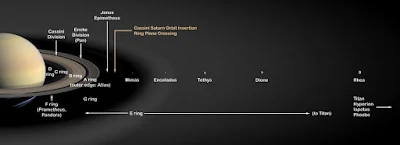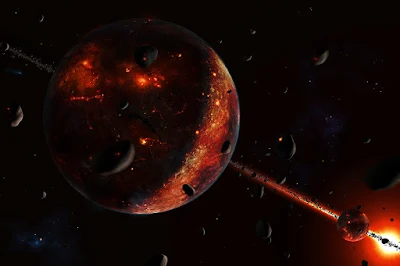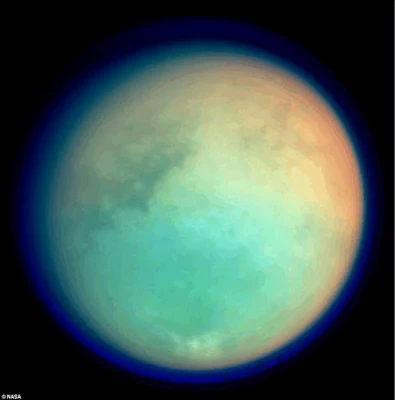Νέα
μελέτη αναφέρει ότι οι δύο δορυφόροι του Κρόνου έχουν ηλικίας μόλις 100 εκ.
ετών. New research suggests that some of Saturn's icy moons, as well as its
famous rings, might be modern adornments. Their dramatic birth may have taken
place a mere hundred million years ago, more recent than the reign of many
dinosaurs. The new paper finds that Saturn's moon Rhea and all other moons and
rings closer to Saturn may be only 100 million years old. Outer satellites (not
pictured here), including Saturn's largest moon Titan, are probably as old as
the planet itself. Credit: NASA/JPL
Μια
εντυπωσιακή ανακάλυψη έκαναν επιστήμονες του προγράμματος εντοπισμού νοήμονος
ζωής SETI.
Similar in many
ways, Saturn's moons Tethys and Rhea (left and right, respectively) even share
a discoverer: Giovanni Cassini, namesake of the NASA spacecraft that captured
this view. The moons are named for sisters -- two Titans of Greek mythology.
Although somewhat different in size, Rhea (949 miles or 1,527 kilometers
across) and Tethys (660 miles or 1,062 kilometers across) are medium-sized
moons that are large enough to have pulled themselves into round shapes. They
are both composed largely of ices and are generally thought to be geologically
inactive today. The view looks toward the anti-Saturn sides of Tethys and Rhea.
North on both moons is up. The image was taken in visible red light with the
Cassini spacecraft narrow-angle camera on Oct. 11, 2015. The two moons appear
close together here, but Tethys was about 220,000 miles (360,000 kilometers)
farther away from Cassini when the image was captured -- nearly the distance
from Earth to our moon. Thus, the view does not accurately reflect the bodies'
relative sizes. Credit: NASA/JPL-Caltech/Space Science Institute
Saturn's moon
Tethys, with its giant canyon Ithaca Chasma. We propose that Ithaca Chasma was
opened by strong tidal forces millions of years ago when Tethys was in an
orbital resonance with the neighboring moon Dione. Credit: NASA
Μελετώντας
τις βαρυτικές αλληλεπιδράσεις ανάμεσα στον Κρόνο και τα δεκάδες φεγγάρια του
κατέληξαν στο συμπέρασμα ότι κάποιοι εξ αυτών όπως ο Τιτάνας και ο Ιαπετός
σχηματίστηκαν την ίδια περίπου εποχή με τον Άρχοντα των Δαχτυλιδιών δηλαδή πριν
από περίπου 4 δισ. έτη αλλά κάποιοι όπως ο Εγκέλαδος και η Ρέα δημιουργήθηκαν
πολύ πρόσφατα και πιο συγκεκριμένα μόλις πριν από περίπου 100 εκ. έτη.
NASA's Cassini
spacecraft captured this view of Saturn's moon Enceladus that shows wrinkled
plains that are remarkably youthful in appearance, being generally free of
large impact craters. Credit: NASA/JPL-Caltech/Space Science Institute
Η
ανακάλυψη είναι σημαντική γιατί εκτός των άλλων ο Εγκέλαδος έχει αναδειχθεί τα
τελευταία χρόνια σε ένα από τα πιο ενδιαφέροντα σώματα του ηλιακού μας
συστήματος και η προσοχή των επιστημόνων είναι μόνιμα στραμμένη σε αυτόν ενώ
εξετάζεται σοβαρά και η οργάνωση μιας αποστολής εξερεύνησης σε αυτόν.
During its final
close flyby of Saturn's moon Enceladus, NASA's Cassini spacecraft revisited a
landscape, and a mystery, that it had originally glimpsed more than 10 years
earlier. In views of this terrain captured during a 2005 flyby, imaging
scientists noticed small dark spots of an uncertain nature. Observing the same
features in this false-color view, at higher resolution than before, provides
some new insights. The spots are evidently large, relatively dark protrusions
of solid "bedrock" ice and ice blocks scattered on and around the
prominent ridge that runs across the scene from north to south (from top center
toward lower left). The ice blocks range in size from dozens to hundreds of
feet (tens to hundreds of meters). To an observer on the surface, the prominent
north-south trending ridge might look superficially like icy flatirons (tilted,
triangular outcroppings of rock), but probably more shallowly dipping than
terrestrial examples. The exposed line of ice blocks along its ridge crest
might make it look a bit like a hogback (a narrow ridge with steep sides, often
with vertical rocky outcrops along the top). On Enceladus, with no wind to
scour loose particulate ice or "snow" off of them, the solid blocks
are probably cleared by some combination of downslope movement of particulates,
and perhaps sublimation. Credit: NASA/JPL-Caltech/Space Science Institute
Όλα
τα στοιχεία που έχουν στη διάθεση τους οι επιστήμονες υποδεικνύουν ότι κάτω από
την παγωμένη επιφάνεια του Εγκέλαδου υπάρχει ένας ωκεανός και μάλιστα κάποιες
μελέτες αναφέρουν ότι είναι φιλικός στη ζωή.
Πηγή: Matija
Ćuk, Luke Dones, David Nesvorný. Dynamical Evidence for a Late
Formation of Saturn's Moons. Astrophysical
Journal, 2016 [link]











